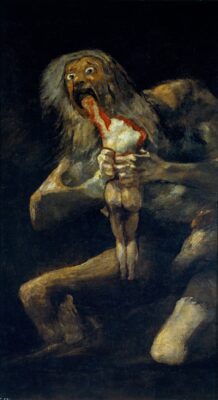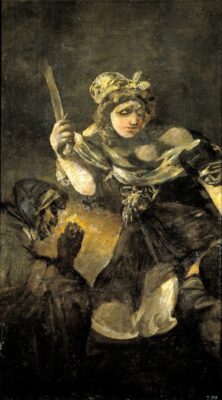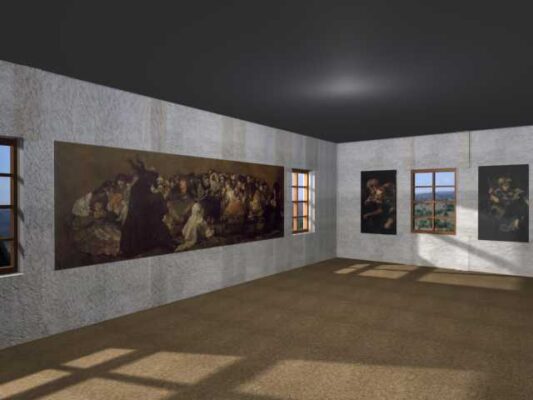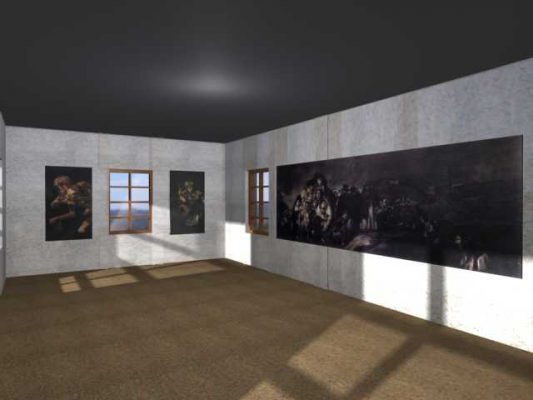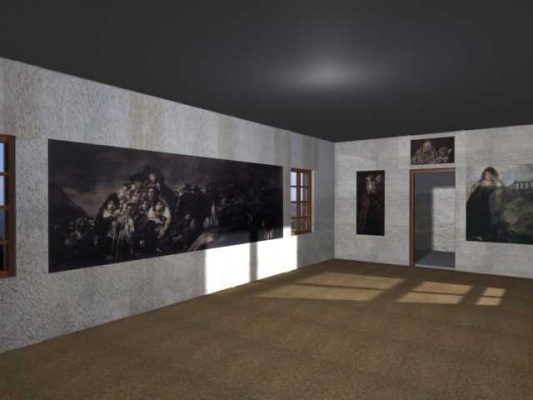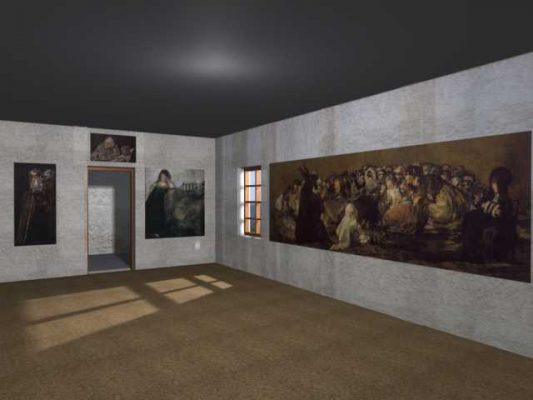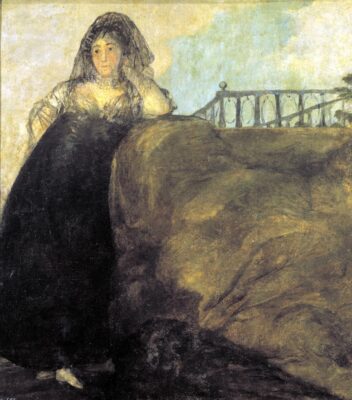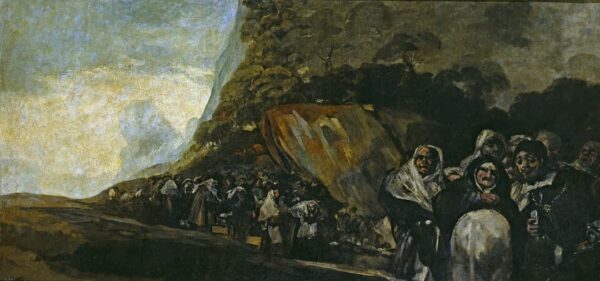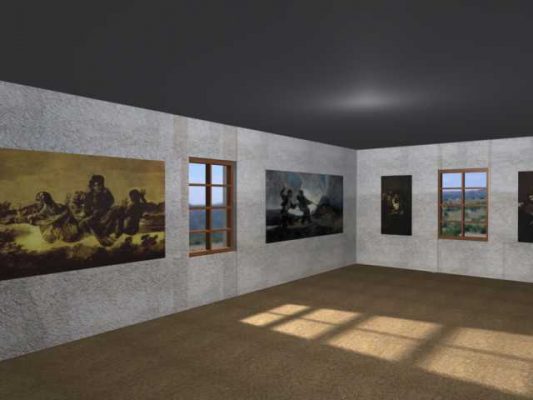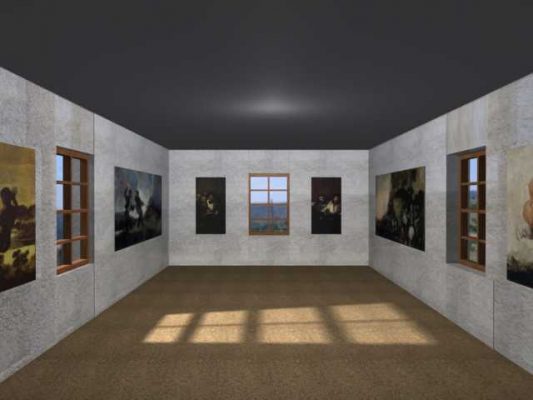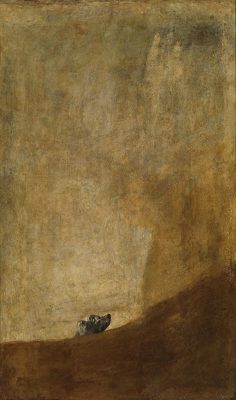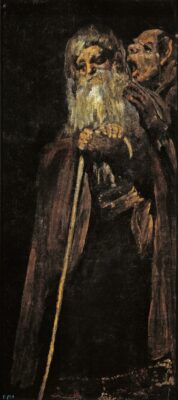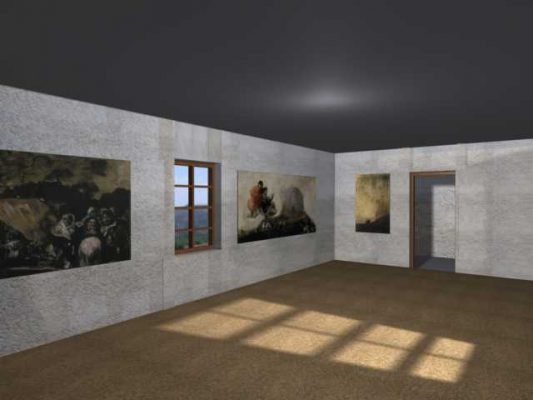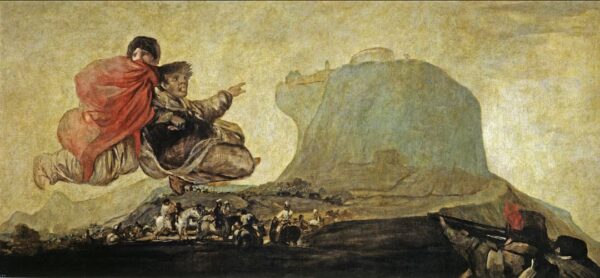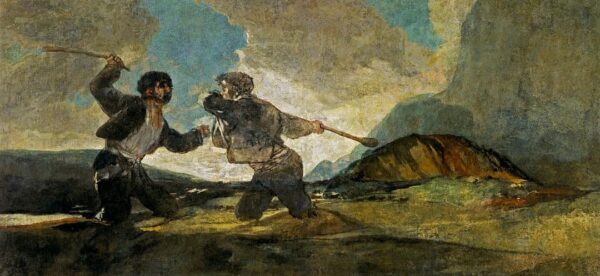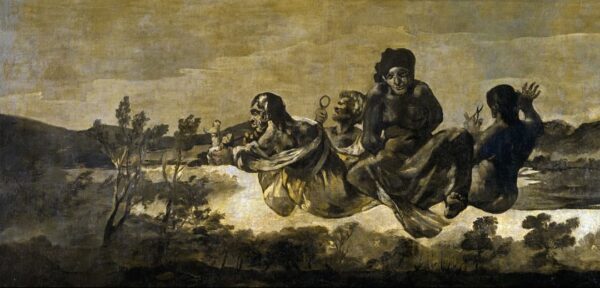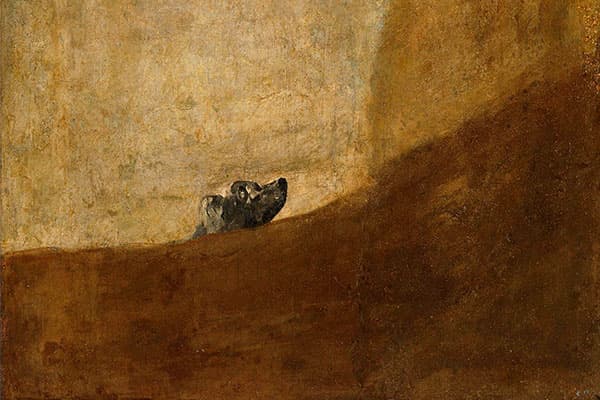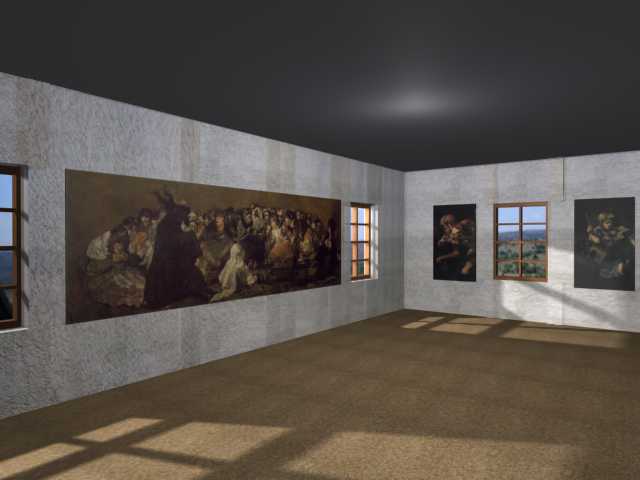Goya · The Black Paintings
by G. Fernández – theartwolf.com
Goya is an enigma. In the whole History of Art few figures are as complex for studying as the brilliant artist born in 1746 in Fuendetodos, Spain. Creative and indefinable, a painter without ¡rival in all of his life, Goya was the painter of the Court and the painter of the people. He was a religious painter and a mystical painter. He was the author of the beauty and eroticism of the ‘Maja desnuda’ and the creator of the explicit horror of ‘The Third of May, 1808’. He was an oil painter, a fresco painter, a sketcher and an engraver. And he never stopped his metamorphosis
Due to all this, most of the biographies that try to cover his entire oeuvre often fall in the indecision and the unwarranted suppositions. But that is not the objective of this brief essay, in which we are going to try to take a somewhat impossible walk through the now destroyed “Quinta del Sordo” (House of the Deaf Man), the original home of the “black paintings”, now exhibited at the Prado Museum, Madrid.
“Saturn devouring one of his sons”, 146 x 83 cm. ··”Judith and Holofernes”, 146 x 83 cm.
A virtual tour in the Quinta del Sordo
This virtual tour through the “Quinta del Sordo” includes renders of the interior of the house, which have been created by theartwolf.com. These images are property of theArtWolf.com. If you wish to include them in your web, please contact us. You are invited to include a limited number of images in your website as long as you include the reference www.theartwolf.com in a visible place.
Lower floor: “Witches sabbath”. The “Saturn devouring his son ” and “Judith and Holofernes” in the foreground ·· “The great he-goat (witches sabbath) “, 140 x 438 cm.
We know very few about about this Quinta and the reasons that brought Goya to “decorate” it with such peculiar paintings after acquiring the house in 1819. The Quinta, located in the outskirts of Madrid, was a medium-sized two floor building to which Goya added a new wing for the kitchen and other rooms. The house had two main rooms -measuring 9 x 4.5 meters- located each one in a different floor. We also know that these rooms had been decorated with rural motifs before Goya moved to the house.
So, why did Goya decide to change this mostly colorful decoration for the restlessness horror of the “black paintings”? Was the desperation after the Spanish Civil War of 1820-23? Not probable. These paintings were initiated one decade after the end of the War, and Goya had already made its particular “anti-war manifesto” with “The Disasters of War”. Was the reason his -at the time- almost total deafness? Or maybe the serious disease he suffered in 1819? The reasons for this decision are still unknown. What we do know -despite the damage suffered by the works when transferred the frescoes to canvases- are the results.
First of all, we have to say that -despite the dark fame of these paintings- not all them were gloomy or terrible. It is true that today almost everybody associates the “black paintings” with the frightening Saturn devouring his son or with the ruthless Duel with cudgels, but in the set we can find pieces without any vestige of horror, like Two women and a man, or even the beautiful figure of the Leocadia, elegant and serene despite her mourning dress. In addition, the rooms, with abundant windows opened to the Madrilenian countryside, necessarily had to receive an important amount of sunlight, so the Quinta must have been far from being the dark place that some historians seem to suggest.
Lower floor: “A pilgrimage to San Isidro”. “Saturn devouring his son” and “Judith and Holofernes” in the background ·· “A pilgrimage to San Isidro”, 140 x 438 cm.
The presence of these windows in the walls organized the distribution of the frescoes in the rooms. Whereas the ground floor hall had two windows in each one of its large walls, the upper floor hall had only one. This allowed Goya to create enormous compositions between the windows of the lower room; while in the upper room he was limited to create just two smaller frescoes in each side of the window. In the smaller walls, to each side of the door or window, and even above them; Goya painted smaller compositions that were somehow related to its larger sisters.
Two big groups of paintings dominated the lower room. Firstly, A pilgrimage to San Isidro appeared along with Judith and Holofernes and Two monks. That carnival of tortured faces that is A pilgrimage to San Isidro has been interpreted in two different ways: first, like a twisted vision of the popular Madrilenian celebration that used to take place a few miles from the Quinta. But there is also a theory that relates it to the Roman celebration of the Saturnalia, dedicated to the Roman god Saturn. Two monks could be related to the unfortunate life of those who found themselves exiled and impoverished after the War. On the other hand, Judith and Holofernes makes reference to a quite famous Biblical story. Peculiarly, this painting is somehow related to “Saturn devouring his son”, in which another mutilated body is shown.
Lower floor: “Witches sabbath”, the “Leocadia”, “Two Monks” and “Old man and old woman” in the background ·· Lower floor: “A pilgrimage to San Isidro”, along with the previously mentioned “Leocadia”,”Two Monks” and “Old man and old woman”
In front of these paintings we would find The Great He-goat (Witches’ Sabbath). This was perhaps the most important painting of the entire Quinta, although when the fresco was transferred to canvas it lost a great part in his right end (which causes a strange asymmetry between the young sitting girl and the great he-goat). The painting looks not exactly frightening, but disturbing and even somewhat parodic. It is quite interesting to compare this work with the one of the same subject that Goya painted in 1798 (Madrid, Lazaro Galdiano Museum), in which the figure of the he-goat, looking directly to the observer, is the unique protagonist of the composition, which does not happen here. This fresco was flanked by “Saturn devouring his own son”, perhaps the most famous of the “black paintings”, still used nowadays as a symbol of the horror and madness.
“Leocadia”, 147 x 132 cm. ·· “Pilgrimage to the Fountain of San Isidro”. 127 x 166 cm.
It is quite possible that Goya knew the version of the Saturn painted by Rubens in 1636 (Madrid, Prado Museum) but he decided to separate his painting from any mythological symbol or interpretation and focus only on the expressivity of the face, reflecting the cruelty of the act. This “expressionist foretaste” is nowadays one of the most popular and instantly recognizable paintings of the Prado Museum.
Opposed to the explicit horror of Saturn we would find the serenity of the Leocadia (also called A Manola: Doña Leocadia Zorrilla), beautiful and keeping the composure in spite of her more than possible relationship with the deceased person who rests in the tomb besides her. It is possible that between this painting and “Two monks”, and placed above the door, there was Old man and old woman eating a soup.
Upper floor: “The Fates”, “Duel with cudgels” ·· Upper floor: general perspective from the entrance.
The distribution is quite different from the lower room, being only one window in every large wall
In the upper room we could find seven paintings. First of all, next to a door, lonely and abandoned, we found The Dog. This is perhaps the most enigmatic painting of the entire Quinta. It depicts a dog, totally hidden except for his head, against an ochre background. We can not know more about the protagonist or the meaning of this fresco. Where is that dog? What is he looking at? Is he sinking, or, on the contrary, he sticks his head out, cautiously, afraid of something we are not able to see? There are many interpretations of this painting, associating the dog to the infernal figure who guides the dead souls to Hell, and suggesting it as a symbol of the abandonment and the neglect.
“The dog”, 130 x 84 cm ·· “Two monks”, 146 x 66 cm
In the great wall located next to this painting were also two great frescoes: Fantastic vision (Asmodea) and Procession of the Holy Office. Asmodeo was a mythological killer demon that Goya represented -we ignore the reason- as a woman who partially covers her face, while floating in the sky carrying a horrified man. “Procession of the Holy Office”, on the other hand, is a brave and ironic critic to this infamous Court.
Upper floor: The pair “Procession of the Holy Office ” and “Asmodea” ·· “Asmodea”, 123 x 265 cm.
In front of these two great paintings were other two: the ruthless Duel with cudgels, and the enigmatic The Fates. The first of them is perhaps the most brutal of all the Black Paintings, along with Saturn, but here we are not looking at any fantastic or mythological scene: this duel is “real”, between two anonymous personages, and it will be only solved by the inevitable death of one of them. This work has been interpreted as an allegory of the Civil War. Contrasting with these two figures -tragically anchored to the ground- the figures of The Fates float in the air, as do those in the Asmodea, placed -not by chance- just opposite to this painting.
“Duel with cudgels”, 123 x 266 cm. ·· “The Fates”, 123 x 266 cm.
In one of the smaller walls of the upper room, Goya created two vertical paintings, smaller in size than the previous ones: Reading and Women laughing. They are evidently less frightening, although chromatically darker, than their companion paintings.
In 1824, Goya left the “Quinta del Sordo” and moved to Bordeaux, France, tired of the Spanish society and reality. “Who cannot extinguish the fire in his house should move away from it”, he wrote shortly before moving away. The Quinta was sold and passed through diverse hands, putting in danger the integrity of the paintings. But in 1874, the then proprietor of the Quinta, the Baron d’Erlanger, ordered the curator of the Prado Museum, Salvador Martinez Cubells, to transfer the frescoes to canvases. The paintings were exhibited at the Universal Exhibition of Paris in 1878, and later they were donated to the Prado Museum, where they are exhibited nowadays.
NOTES ABOUT THE TOUR
We have taken into consideration the limited information we have about the specifications of the Quinta (dimensions of the rooms, location of the paintings.) We know that the walls were decorated with floral motifs, but -as we do not have a photography or a reliable depiction of such decoration- we have chosen a neutral background. We have not included any piece of furniture, and the natural light could have been quite different.
IMPORTANT: This virtual brief tour in the “Quinta del Sordo” includes renders of the interior of the house, which have been created by theartwolf.com. These images are property of theArtWolf.com. If you wish to include them in your web, please contact us. You are invited to include a limited number of images in your website as long as you include the reference theartwolf.com in a visible place.
Follow us on:

